

Huh?


(A true story from Associated Press, by Kurt Westervelt)
On March 23, 1994 the medical examiner viewed the body of Ronald Opus and concluded that he died from a shotgun wound to the head. The decedent had jumped from the top of a ten story building intending to commit suicide. He left a note to that effect indicating his despondency. As he fell past the ninth floor, his life was interrupted by a shotgun blast passing through a window, which killed him instantly. Neither the shooter nor the decedent was aware that a safety net had been installed just below at the eighth floor level to protect some building workers and with that Ronald Opus would not have been able to complete his suicide the way he had planned.
Ordinarily, Dr. Mills continued, "a person who sets out to commit suicide and ultimately succeeds, even though the mechanism might not be what he intended" is still defined as committing suicide. That Mr. Opus was shot on the way to certain death nine stories below at street level, but that his suicide attempt probably would not have been successful because of the safety net, caused the medical examiner to feel that he had a homicide on his hands.
The room on the ninth floor from whence the shotgun blast emanated was occupied by an elderly man and his wife. They were arguing vigorously, and he was threatening her with a shotgun. The man was so upset that when he pulled the trigger he completely missed his wife and the pellets went through the window striking Mr. Opus. When one intends to kill subject A, but kills subject B in the attempt, one is guilty of the murder of subject B. When confronted with the murder charge, the old man and his wife were both adamant. They both said they thought the shotgun was unloaded.
The old man said it was his long standing habit to threaten his wife with the unloaded shotgun. He had no intention to murder her. Therefore, the killing of Mr. Opus appeared to be an accident, that is, the gun had been accidentally loaded. The continuing investigation turned up a witness who saw the old couple's son loading the shotgun about six weeks prior to the fatal accident.
It transpired that the old lady had cut off her sons financial support the son, knowing the propensity of his father to use the shotgun threateningly, loaded the gun with the expectation that his father would shoot his mother.
The case now becomes one of murder on the part of the son for the death of Ronald Opus. Now comes the exquisite twist. Further investigation revealed that the son was in fact Ronald Opus. He had become increasingly despondent over the failure of his attempt to engineer his mother's murder. This led him to jump off the ten story building on March 23rd, only to be killed by a shotgun blast passing through the ninth story window. The son had actually murdered himself so the medical examiner closed the case as a suicide. Very tidy of him.
Squirrel Fishing
A new approach to rodent performance evaluation

The Division of Engineering and Applied Sciences (the buildings
in this photograph) has significantly
expanded its Computer Systems work in recent years. However, there has
been a noticeable lack of quality work on Rodent Performance Evaluation.
This study is a first attempt to remedy this deficiency.
We chose gray squirrels as our subject of study because of their
abundance in the immediate surroundings of the Aiken Computation Lab,
with many large oak trees nearby.

Early attempts to measure squirrel performance involved chasing them
around and trying to guard all nearby trees by a sufficient number of
researchers, but these efforts were mostly fruitless.
Another method involved building primitive traps from cardboard boxes
and 10baseT Ethernet cables, but these cables either attracted unwanted
attention or got lost high up in trees.

Some insight was gained, however, into ways of focusing squirrels attention
on small objects which are dropping on the ground, such as acorns. This
led to the formulation of Gloy's First Conjecture that a squirrel
will always give up one acorn if another one is thrown nearby.
This led to our current approach to measure the reaction of squirrels to a
peanut tied to a long piece of string. The low end of the performance scale
includes not running away from a peanut thrown at the subject, and
following it as it is dragged through the grass. The aiming accuracy of
the trowing process can be greatly increased by attaching a key to the
string about 3 inches from the end.
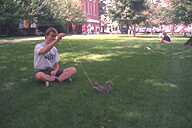
The next point on the performance scale is the willingness to grab the
peanut and hold on to it under moderate tension.

A smarter squirrel will discover after a while that it is better to
bite through the string than simply pull on the peanut. This
distinguishing tactic leads us to believe that the average squirrel
performance in Texas is much higher than in Massachusetts.
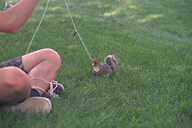
Prolonged lack of success in consuming the peanut can lead to frustration,
as shown on the face of the squirrel in this picture. Note that in
this experiment, a magnet found on a mouse cable was used as a weight
to improve throwing precision, rather than a key as mentioned earlier.

Because of the complexity of the resulting photographs, with uneven
focus across the field of depth, these images are now widely used
in computer graphics teaching and research.
Professor Steven
J. Gortler
is considered the leading authority in this subfield.
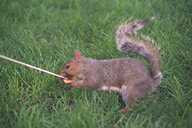
Another attempt a biting through the string. The low-quality string
used in this phase of our experiments made this a little too easy.

Another question that has been puzzling researchers for years is
whether it is possible to make a squirrel fall on its back by skillful
manipulation of a bait suspended above its head. The theory was that
this could be achieved if this bait was moved in a straight line over the
center of gravity of the squirrel towards its back.

After many hours of experimentation, we were able to disprove this theory.
More research is needed to determine if squirrels get dizzy from
prolonged spinning around.
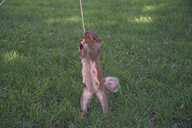
The highest mark on the squirrel performance scale is achieved when
a subject is willing to hold on to the peanut or string while it is
being lifted off the ground. This state only lasts for a very short
time and is very difficult to photograph.
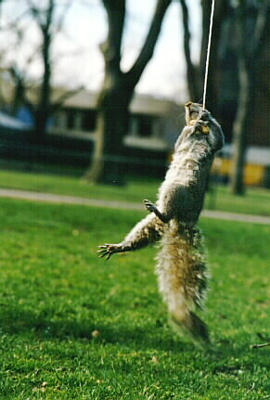
LIFT OFF !!!!
